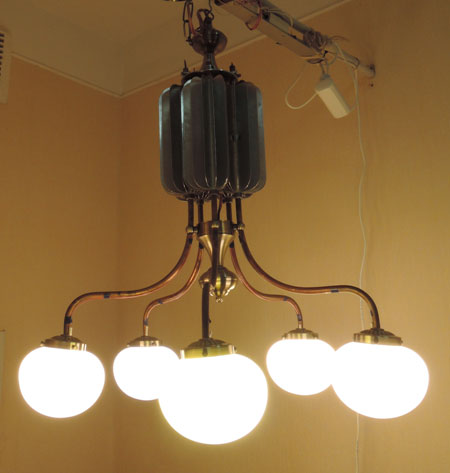Development and research of energy-saving LED chandeliers with heat pipes for indoor lighting.
Up to 30% of the produced electricity is being spent on the lighting in Ukraine. Therefore, the problem of energy saving in lighting stands very seriously. Introduction of energy-saving technologies in the internal lighting systems will provide significant energy savings and improve the ecological condition by reducing atmospheric discharges of thermal power plants.
It is possible to achieve energy saving in lighting by introducing LED-based light sources, the luminous efficiency of which is 10 times the light output of incandescent lamps and 2 times – the compact fluorescent lamps, which contain mercury.
The main problem in creating energy-efficient lighting systems for indoor lighting by using LED lamps of direct replacement in existing chandeliers is the insufficiency of heat removal from LEDs of the lamp, which limits their power to 8–12 Watts, and restricts the luminous flux accordingly. Therefore, the possibilities of the use of direct replacement lamps instead of incandescent ones in traditional chandeliers as the lighting facilities for modern premises are limited and hampered by the unresolved problem of heat removal.
In this research work the world's first new approach is proposed and implemented for building a strongly energy-efficient LED chandelier for indoor lighting of premises. The approach consists in the implementation of elements of the decorative frame of the chandelier in the form of high-performance heat transfer devices - heat pipes, and using LED modules as a light source. As a result, the LED modules power (24 W) and their emitted light output is increased by 2-3 times as compared to the case when 8-12 Watts direct replacement LED bulbs are used in the same chandeliers. This allows reducing the number of chandeliers required for indoor lighting by 2 to 3 times. At the same luminous radiation flux the power consumption (120 W) of the developed 5-jar chandelier is 5-10 times less than the consumption of the chandelier with incandescent bulbs (600-1200 watts). By reducing the power consumption, a reduction of the volume of harmful emissions on thermal power stations is achieved as well as the reduction of environmental pollution.
A model LED chandelier with heat pipes was produced. The following results were obtained experimentally: new dependencies of the LED modules temperature on the heat flux in a free and forced convection regimes; the value of the maximum heat flux, which can be transmitted from the LED modules by the heat removal system; the coefficients of heat transfer in the heating and condensation zones of heat pipes; the influence of the heat pipe orientation on the thermal characteristics; the value of the contact thermal resistance between the LED module and the heat pipe.
Sketching design documentation was developed for the layout of chandeliers and engineering methods for calculation of the chandelier thermal characteristics.

| Долучення | Розмір |
|---|---|
| 702.63 КБ |




